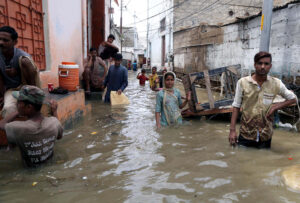
We’ve discussed in previous blogs how rebuilding after a natural disaster could mean continuing to do the same thing while expecting the results to be different. The problem is becoming more complex as climate change makes natural disasters more frequent and more severe.
Pakistan suffers the consequences of climate change more than most countries. Even though its own contribution to greenhouse gas emissions is relatively low, Pakistan’s annual monsoons are bringing much more rain than they used to. Floods drive more and more people from their homes, killing 1700 people last year. Most of these people don’t have a lot to begin with, so how can they rebuild?
Rebuilding for resilience against flooding
Yasmeen Lari, Pakistan’s first woman architect, has turned the attention of her Heritage Foundation to exactly this question. A model village in Sindh province has demonstrated the effectiveness of her simple houses—simple enough for villagers to build. They use sustainable, traditional materials and incorporate flood-resistant measures. These include building on higher ground, putting the house on a platform to raise it higher, and shaping the roofs to direct water away from the house. Once villagers learn the necessary skills, they can build homes for themselves and others.
It’s made out of eight prefab panels. And then it has a structure, a roof which is like an umbrella. So, there’s a huge amount of air movement. So it’s very comfortable inside. My own dream is really that if I could just save people from displacement, they could be just these structures which will make sure that people can stay in them.—Yasmeen Lari
Video: Fred de Sam Lazaro reports for PBS News Hour on how Pakistan is rebuilding for resilience against future flooding.
Because we are higher, we were safe. People in other villages had to run to the roadways because they were lower down. And the water just drained off the roof, away from the house.—Khumo, model village resident
Rebuilding for resilience against earthquakes
Pakistan is subject to seismic activity as well as flooding. Resilient infrastructure needs to withstand it all. The 2013 earthquake in Balochistan and the 2015 earthquake in Shangla prompted the Heritage Foundation to design shelters using bamboo cross-bracing. When prototypes were tested at NED University in Karachi, they withstood shaking six times as severe as the 1995 earthquake in Kobe, Japan.
Disasters can be truly devastating and people easily fall into deep depression. But if you give them something to do, it really helps with recovery. Something people have helped to make is much more valued than something simply given—Yasmeen Lari
By using inexpensive, local materials such as bamboo, mud, and lime, villagers can rebuild for themselves and feel secure in their homes, knowing they’re prepared for whatever comes next.
Making a living
Naturally, people need more than a roof over their heads. To lift people out of extreme poverty, the Heritage Foundation has developed a stove that makes cooking easier and more healthful than cooking over an open fire. Making the stoves provides a source of income for residents of the model village. Village women have led the production and sale of these stoves.
Suddenly, women’s postures changed…they were crouching on the floor, on the ground. And, suddenly, every woman’s back was erect. Suddenly, she was proud, as if she was sitting on a throne. And women are in the lead in everything that I’m doing. And once they’re strong and confident, I think they will make it—they will bring about a change. And we have got to bring about a change. We can’t go on like this.—Yasmeen Lari
It’s not only women who benefit from these stoves. Because they generate less smoke than cooking fires, everyone breathes cleaner air.
The Heritage Foundation has also promoted the use of basic building components that villagers can produce and sell. Each village specializes in its own product, whether bamboo panels, mud bricks, or ceramic tiles. Trade in these products among villages has raised over 80% of participating communities out of poverty.
I think we often misunderstand what kind of help is needed. As an outsider, you do things that you think are appropriate, but the reality here is different. The aid mindset is to think of everyone as helpless victims who need things done for them, but we have to help people to do things for themselves. There’s so much that can be done with what’s already there, using 10 times less money.—Yasmeen Lari
